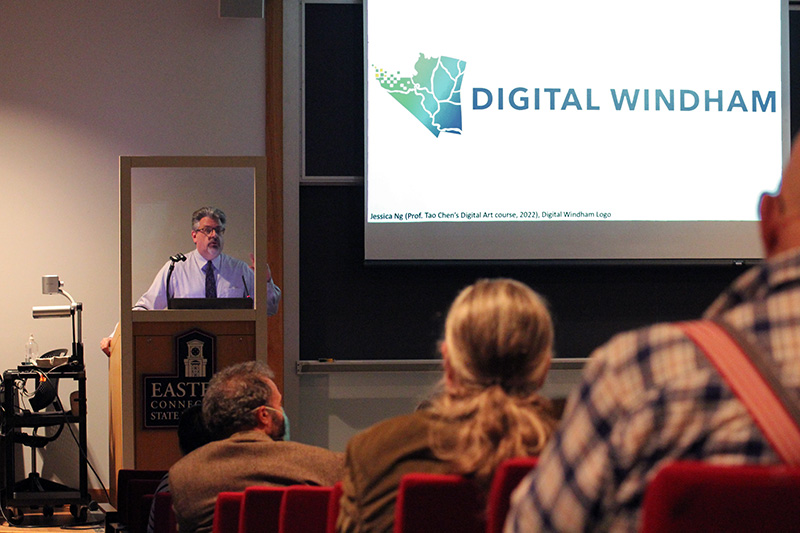- Apply
- Visit
- Request Info
- Give



Published on May 17, 2022

The History Department at Eastern Connecticut State University hosted its grand opening presentation of “Digital Windham” on May 4 in Webb Hall. Digital Windham is the flagship project of Eastern’s Digital History Lab (DHL), and is an ongoing effort to capture and preserve the history of Windham in website form using digital techniques.
The DHL is a collaborative space that is host to a suite of hardware and software to support a variety of digital history projects by Eastern students and faculty. Jamel Ostwald, coordinator of the DHL and chair of the History Department, explained that “digital history” at Eastern includes digitizing sources, utilizing computer programs and other digital tools to analyze those sources, and presenting the results in a digital format.
“History is traditionally an analog discipline,” said Ostwald. To help manage the “information overload” of historical documents, he said “computers can supplement historian’s research efforts with automation and the ability to analyze thousands of documents… this is revolutionary.”
“History students are traditionally afraid of technology,” joked History Professor Anna Kirchmann, co-founder of the DHL, who is retiring from Eastern after 24 years of teaching this June. “We’re changing that.”
“Windham is a sort of social lab for historians,” said Kirchmann, quoting retired History Professor Emil Pocock, who helped focus the department’s attention on the local history right outside Eastern’s campus — an effort that has ultimately led to Digital Windham.
In addition to being an area rich in history, Kirchmann say’s Windham is home to many history buffs and historical institutions. To supplement their research, history students are encouraged to peruse downtown Willimantic “to feel the physical presence of history.”
Eastern currently offers two digital history courses: “Intro to Digital History” and “Digital Windham.” Students enrolled in the latter create interactive maps, timelines, blog posts and other “exhibits” for the publicly accessible website. Timelines recap the rise and heyday of Windham, while blog posts delve into significant and lesser-known local people, places and events.
History major Madison Cotner presented on her contribution this semester to Digital Windham, by writing a blog post about Daniel Dunn, Windham’s first Irish mayor. She explained that studying local history presents new challenges, as there is often less information published about research subjects.
Her primary sources included early 1900s census information, the Hartford Courant’s online archives and back issues of the Willimantic Chronicle via the DHL’s microfilm reader. For photos, she found a portrait of the mayor in the town hall. “I interacted with a lot of sources I typically wouldn’t have worked with,” said Cotner.
History major Max Turner presented on his blog post about Amelia Peterson, a mill worker from the 1880s who resided in a boarding house. Speaking to the shortage of published information, he said, “(This was) a parable of the challenges inherent in telling local histories.”
To read Cotner and Turner’s blog posts and to see other Digital Windham exhibits, visit http://easternct-digitalhistory.com .
To read an EASTERN Magazine article about the Digital History Lab, visit https://www.easternct.edu/magazine/issues/2022/spring/future-historians.html .
Written by Michael Rouleau